St. Catherine University was opened as the only welfare-oriented university in Ehime Prefecture in 1998. Flexibly responding to the dramatic transformations of today's society which is changing at a dizzying pace, the school has raised a large number of students and has connected people with people, and people with communities. In addition, the university has actively engaged in industry-academia-government collaboration projects to contribute to and revitalize local society, including the development of "dried food that can be eaten bones and all" and "functional wall materials for elderly facilities", and is developing them as educational tools for students. This article introduces an industry-academia-government collaboration project in 2019-2020 that involved developing textile products for nursing care with the aim of improving the quality of life (QOL) of the elderly, with student participation.
The launch of the project
The development of textile products for nursing care started with the employees of the towel manufacturer Top Factory Imabari (Imabari City, Ehime) constantly "worrying about the nursing care of their parents." With the development of Japan's aging society, they are living in an age where people live well into their 90s and 100s. The term 'nursing care' is emblematic of Japanese society today and has long been closely related to their daily lives. People try to live in harmony with those around them in society, eating what they want to eat, wearing what they want to wear, and using tools they like. This remains true even if nursing care is required, so it is necessary to provide support that respects the wishes of the recipient and facilitates independence. In addition, considered from the viewpoint of a "fulfilling lifestyle," individuals have different values and ideas, but most people can agree that what is necessary to ensure that fulfillment is the provision and development of services for living safely and with peace of mind, as well as appropriate measures to fulfill individual wishes about "food, clothing, and shelter." The context of this project is the continuation of "comfortable living" that fulfills the individual desires of elderly persons in need of such care.
Concrete initiatives
The project was developed through collaboration between the Department of Social Work, Faculty of Health and Welfare Human Services, St. Catherine University, Top Factory Imabari, and the Textile Industry Technology Center, Ehime Prefectural Research Institute for Industrial Technologies as well as in cooperation with 21 welfare facilities for the elderly in Ehime Prefecture (Figure 1). It is characterized by information collection and analysis, for example, through a questionnaire survey of staff and residents of elderly welfare facilities, and was developed through repeated PDCA cycles (Plan, Do, Check, Action) of improving and verifying prototypes. Furthermore, the project was implemented as a collaborative project with student participation, utilizing their specialized knowledge and skills in welfare and nursing care.
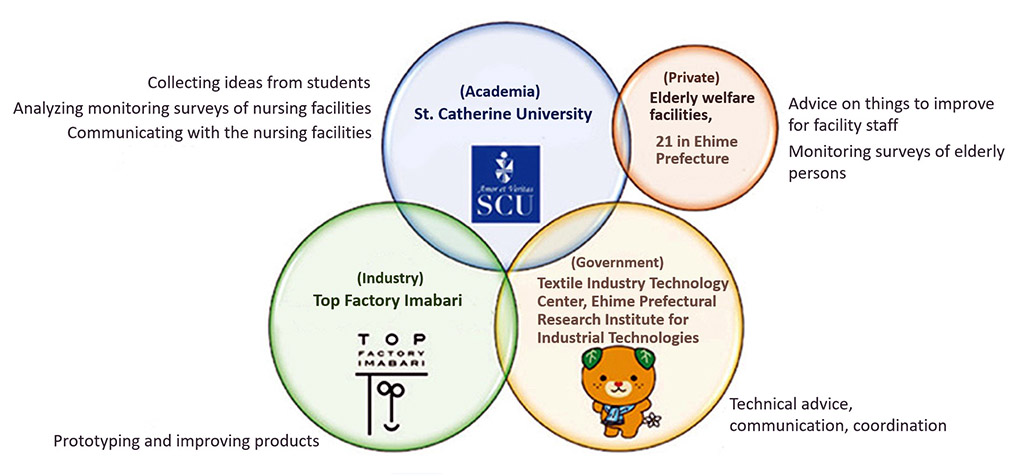
Several rounds of monitoring surveys have been conducted to repeatedly improve the product by taking advantage of the features of each specialized institution. For example, for prototyping, product improvement, and market development, "academia" for the implementation and analysis of monitoring surveys and proposals for product development, and "government" for technical advice on the products and liaising with the relevant agencies, and so forth. During this product development period of about a year and a half, the project group examined materials, shapes, colors, package designs, and product names to be used through lively exchanges of opinion with students and elderly welfare facility staff centering on the industry-academia-government axis(Table 1).
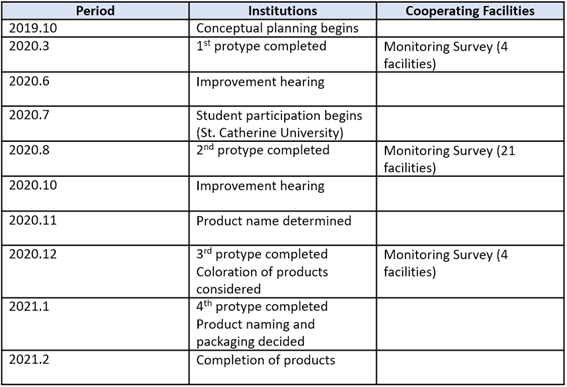
As a result of the aforementioned efforts, it was decided to develop (1) the mealtime apron "Maite Meal," (2) the nursing care body towel "Kimekomaka," and (3) the self-support bath mitt "Aratte Mitten".
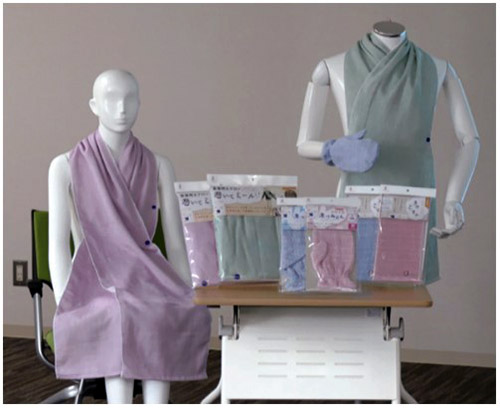
(1) The mealtime apron "Maite Meal"
This product is a scarf-type apron that aims to make mealtimes enjoyable. In addition, it has a fashionable design that can be used in non-mealtime settings by changing its orientation. It is characterized by a doubled crossing of the fabric in front and a length that covers everything down to the knee when sitting. It has enhanced water resistance to protect against the spillage of food and beverages. It can also be adjusted to body size and use through the placement of a blue snap button with high visibility that can be set in two positions, making it easier to wear for residents and caregivers. Since the towel fabric is 100% cotton, it irritates the neck area less, has high breathability and heat retention, and can be worn comfortably in any season.
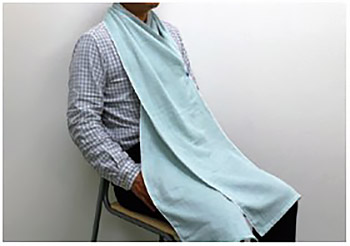
(2) The nursing care body towel "Kimekomaka"
This product aims to gently wash the sensitive skin of elderly users. It is characterized by a size about half that of a regular bath towel, making it easy to hold when folded and not too heavy when wet. It is made of 100% cotton gauze and has "mosha-ori" weaving on the back of the fabric to create more foam. The fine foam makes it easier to clean pores while reducing skin damage compared to hand washing.

(3) The self-support bath mitt "Aratte Mitten"
This product aims to support independence when bathing. It is characterized by a mitten-type design that can be worn on both the right and left hand to allow users to wash themselves even if they have reduced grip or limited finger mobility. Moreover, rubber was applied to the cuff, thus making it tighter, easier to put on and take off, as well as preventing it from coming off during washing. Like the nursing care body towel "Kimekomaka," it is 100% cotton gauze, and the back of the fabric uses "mosha-ori" to ensure better cleanliness through fine foam and prevent rough skin due to excessive friction. In addition to supplementing basic human desires, all of these products are expected to expand the range of activities users can do in their daily life, increase the number of activities they engage in, and boost their everyday motivation. The project group hopes that they can reduce patients psychological resistance to "receiving care" and promote social participation.
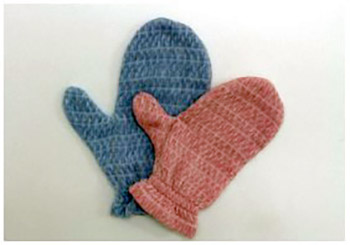
Future prospects and challenges
Based on the university's founding spirit, educational philosophy, and goals of education and research, St. Catherines is promoting social collaboration and contributions to society with the aim of giving back the results of their education and research activities to society at large. their industry-academia-government collaboration projects have involved product development mainly on the theme of "universal design" (UD), but in this project, for the development of textile products for nursing care, they have not only tried to reflect as much as possible the opinions from the nursing care field as it is struggling due to the COVID-19 pandemic but also accomplished their initial goal as it has been a valuable learning opportunity with active student participation. In the field of nursing care, it is fundamental to provide services to those requiring such care, and an indispensable part is the efforts to improve their living environment as well as tools and equipment used on a regular basis with the goal of enhancing QOL. Especially for residents of elderly welfare facilities, professional intervention is required in the pursuit of comfort, convenience, and safety in the areas of "food, clothing, and shelter."
Meanwhile, ease of use and safety for the caregivers is another important perspective. The project group intends to keep improving these products they have developed as needed by continuously collecting feedback from users (care receivers and caregivers) while also utilizing their relationships with facilities that they have built through this collaboration project to explore the diverse needs in the field and develop UD products to improve the nursing care environment. In addition, they hope that these activities can lead to diverse learning opportunities for their students. Putting universities' intellectual resources to use is an important initiative for local area revitalization.
The Grand Design for Higher Education toward 2040 (Report) (Central Education Council No. 211) calls for education that broadens the scope of learning as well as educational programs that are diverse and flexible. Student participation in industry-academia-government collaborative projects can be expected to foster basic social competence through interactions with diverse companies and local residents as well as to improve students' practical skills as assistants through active learning and project-based learning. The university, whose aim is to become "a university that is loved by the community and develops with the community," intends to collaborate with various companies, organizations, institutes, and government agencies, strive to create "knowledge" and innovate "technology" centering on the university, and contribute to improving people's QOL.
Professor Kazunori Tsuneyoshi, Professor Masae Akiyama, Noriko Muraoka, and Lecturer Shinji Ogiso, Department of Social Work, Faculty of Human Health and Welfare, St. Catherine University




